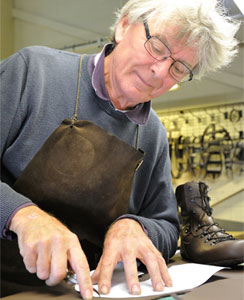
The card section patterns are used to cut the leather or fabric pieces for the boot upper. Sample revisions are made and revised uppers are cut many times. This process is repeated until the bootmaker is happy with the sample size of new boot.
At the end of the design process we have one size of boot. Now it is necessary to convert the sample size into all sizes. This process is called grading.
At Altberg I still grade in the way I was shown by William Shepherd and his son John of the old Richmond shoe factory. From the centre of the pattern, radial lines are drawn to all key points. A grading number is calculated, this number is used to set the Vernier dividers. The sizes are then marked along each radial line.